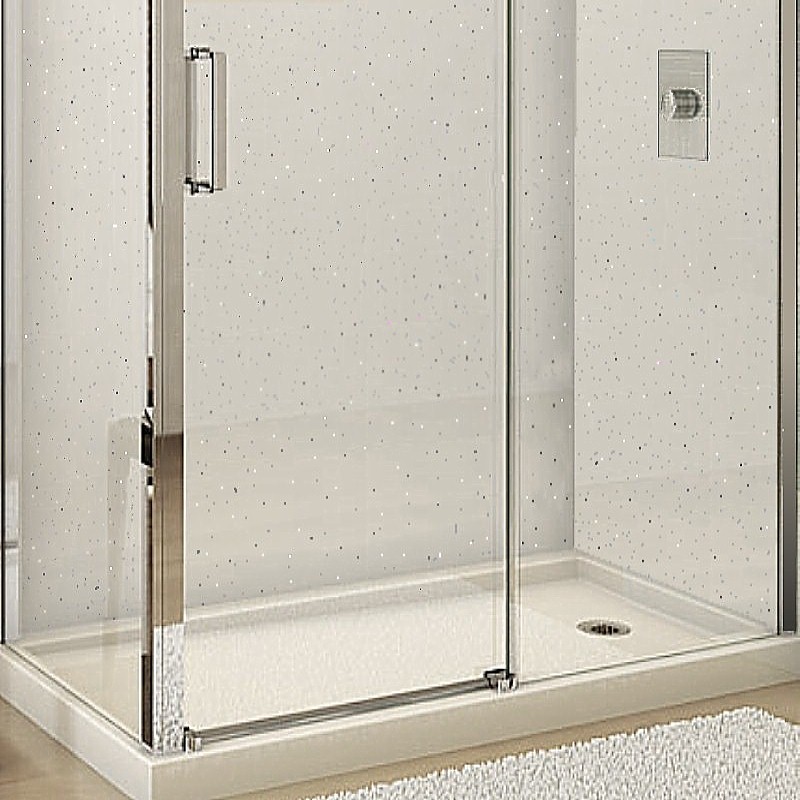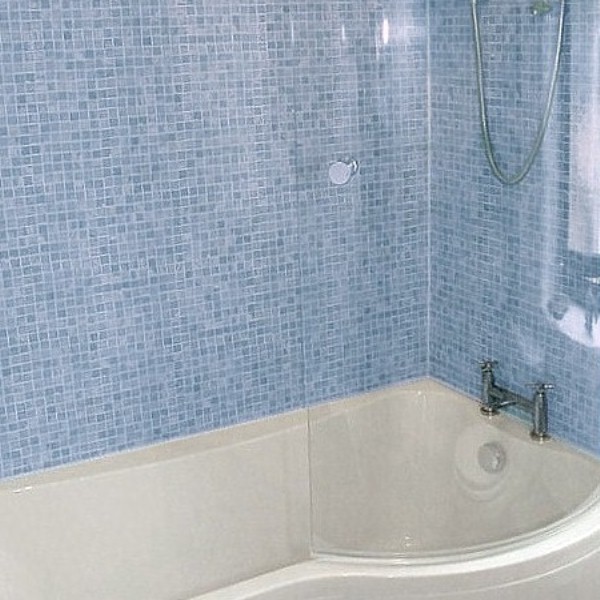Our guide to choosing the right shower cubicle will help you make sense of the myriad options you are presented with.
Which shower cubicle is best? Are shower pods a better option than a tiled shower? Are panels better than tiles?
There are no easy answers and a lot will boil down to individual circumstances, personal taste, structural variations and budget. Each has a bearing on the best option so we will go through the details.

What Size Cubicle Should I Choose?
You should generally opt for the biggest cubicle you can fit into the bathroom – comfortably.
The word “comfortably” is important as you do not want it to overpower your room. You need to be able to use the other items in the bathroom without feeling too cramped.
Many bathrooms do not have enough room for both a shower and a bath. In this case, you will need to choose between one or the other.
You might have enough room for a bath and a very small cubicle. Be wary of this option. Very small cubicles can be impractical. And they can feel claustrophobic. We would recommend visiting a showroom and physically standing in a small shower before purchasing. You will be able to see for yourself if it is suitable.
What Shape Shower Cubicle Is Best?
This will depend on many factors. The size of the room, the available space, even the position of fixed items like windows and doors.
Quadrant showers look great and can actually save you a little bit of space compared with a square or rectangular cubicle.
We have a separate article that deals with all of these issues and recommends the right product according to the requirements and restrictions:
Are Hinged Or Sliding Doors Best?
Hinged doors are a simpler design than sliders. There are no rollers to break. And no channels to clog up. But sliding doors can be a real bonus in a small room. They do not open out into the room. So you can install other items closer than would be the case with a hinged door.
Bi-fold doors also open into the cubicle. But again make sure you are happy with the amount of access they provide. They can be problematic for larger people especially combined with a small cubicle.
Make sure you allow room in your design to enable a hinged door to open fully. Avoid positioning a basin too near a hinged door. You do not want it to smash up against the porcelain.
There are also walk-in cubicles that do away with moving doors altogether. These are much bigger showers – this design does not work with small units as too much water would escape.
Shower Tray Materials
Shower trays can be made from one of several materials
- stone resin
- acrylic
- porcelain
- steel
The first two are by far the most common.
Stone resin trays are solid in construction and provide a stable base for your shower. They do not usually have legs. If you need to run pipe-work under your tray, above the floor, you will need to raise it up.
Acrylic trays have a baseboard with fibreglass reinforcing. They have adjustable legs to enable them to be installed above surface pipe-work.
Both materials are proven in the marketplace. Stone resin trays can lose their shine after a while. Acrylic trays can be a little more prone to movement especially if they are not installed correctly.
Porcelain and steel trays tend to be used in commercial situations. They are a more expensive option but will perform well in domestic environments. Both have a hard-wearing surface that will not dull with use.
See this article for more information on shower trays.

Shower Pods v Shower Enclosure
Shower pods (sometimes called shower cabins or self-contained showers) are a great new idea. They were introduced to eliminate the frequent leaks that people were having with traditional shower cubicles.
The shower tray and wall are moulded as one piece in most designs. This ensures no water can escape from this joint. This is a notorious weak spot with standard showers.
Initially, shower pods were made as one-piece units. But this severely restricted the size of shower that could be made. At the end of the day, the unit would have to fit through a standard household door in one piece.
Models such as the Leak Free Shower overcame this problem by moulding the tray and lower wall as one half and the upper half of the wall as a separate moulding. Each section is still large so this has to be taken into account if access is restricted in your situation.
Traditional showers do not have this problem as each component is separate and can be assembled in situ. But they do have several drawbacks over shower pods The biggest problem is a tendency to develop leaks over time if not installed correctly.

Why Do Shower Cubicles Leak?
Shower enclosures should be waterproof but many people end up with leaks. This is a problem that will cause a lot of damage if left unchecked.
Unfortunately, there is no one answer but poor installation or specification of the wall coverings are the main culprits. Any movement in the shower tray will always cause a leak as will the wrong grout. You need to use a flexible grout or cracks can form. And regardless of how small they are these cracks will lead to problems.
The worst combination of all is a tray that has a degree of movement and grout that is brittle. In this situation, a leak will develop quickly.
We have a separate article that deals with all of the causes and cures for leaking showers here:

Will Shower Wall Panels Help Prevent Leaks?
Yes. But the solid installation of the shower tray is still critical. There is no grout used with these panels so the likelihood of leaks is drastically reduced because these panels do not deteriorate over time.
If you have the option choose a shower tray that has upstands – thin fillets of the tray material that slot up behind panels or tiles. With tiles, the upstands have a habit of loosening the tiles if there is shower tray movement but with panels, this problem simply disappears.
If you cannot get hold of a tray like this or you are having to use one you have already bought there are kits available where you bond a strip onto the side of the tray and this then slots up behind the panels or tiles. Abacus Bathrooms have such a kit available
The other big advantage of shower wall panels is that there is no maintenance. There is no grout to turn mouldy so the panels just need a wipe over to keep them looking pristine.
Shower Cubicle Or Bath?
This is another tricky question and one to which there is more than one answer. It all depends on your circumstances.
Cubicles look impressive and are great for properties that are not considered to be family homes. A bath will be on the shopping list for people with small children when they look at properties but then many buyers rip out the bathroom and start from scratch regardless of what is in situ.
A shower bath is a great compromise offering extra elbow room over a standard bath but allowing you to soak away your worries when you need to.
This article has more information on making this decision: Shower Or Bath
A Quick Word About Quality
When facing the task of refurbishing a bathroom the costs will soon start to look daunting. There are bargains to be had out in the marketplace but always beware of the very cheapest products – they are not necessarily the best value for money as they do not take quality into account.
The shower tray is the most critical part of the installation. So thin, flexible units should be avoided at all costs or you will just be installing yourself a problem.
The enclosure itself is not as critical but you will always know a good quality unit as it will feel solid. Buying online means that you cannot test the quality yourself and the doors could end up feeling flimsy.
Cheap shower wall panels will always out-perform tiles purely from the fact that they use no grout. The more expensive wall panels use wood in their construction. We recommend opting for an all PVC panel as there is nothing to swell up or warp should it come into contact with water.
Conclusion
You can see that there is a lot to take into consideration when choosing a shower cubicle. Take your time, do your research and ask lots of questions of your supplier.
We hope our guide to choosing the right shower cubicle has been useful.
0 Comments
Leave a reply
You must be logged in to post a comment.






